Yungang Grottoes Caves & Pingyao
4-day tour of UNESCO World Heritage
sites of
Yungang Grottoes, Hanging Temple, The Qiao Courtyard and
Pingyao
Highlights:
* Tour the Yungang Grottoes, a UNESCO World Heritage
Site and an incredible example of ancient Buddhist art
and carvings
* Discover the ancient town of
Pingyao, one of the only
cities in China to maintain its ancient city walls and
streets. Being here will transport you back in time to
the China of yesteryear. The city is something of a
living museum
* Walk along the Hanging Monastery, one of the most
curious and interesting places in China. Depicted in
numerous travel magazines and shows, the Hanging
Monastery, set against a large mountain cliff, is a
paradigm of the ingenuity of ancient Chinese
architecture and design
What Pingyao and Yungang Grottoes
Give You:
Pingyao, a UNESCO World Heritage Site, is an
exceptionally well-preserved traditional Han Chinese city.
Its city walls, old temples and courtyard houses were built
in the Ming and Qing dynasties. Located on the old trade
route between Beijing and Xi'an, Pingyao was one of the
flourishing trade centers in northern China. It was here,
where China's first banks were set up in the early 18th
century which rapidly developed into a widespread network of
banks all over the country. One of China's four most famous
"Buddhist Grottoes", Yungang Buddhist Grottoes are 16
kilometers west of Datong. 53 caves are cut into the
southern cliffs of Wuzhou Hill which contain over 50000
magnificently carved Buddhist statues.
One of China's four most famous "Buddhist
Grottoes", Yungang Buddhist Grottoes are 16 kilometers west of
Datong. 53 caves are cut into the southern cliffs of Wuzhou Hill
which contain over 50000 magnificently carved Buddhist statues.
DAY-BY-DAY DETAILED ITINERARY:
*B* for Breakfast
Day
1: Beijing-Pingyao (by fast train-first class) (L)
You will take the morning bullet train
D2001 (07:58 am) from Beijingxi to Pingyao Old Town, Upon
arrival at the train station at 12:13 noon, you will be welcomed
by your local English-speaking guide, and he/she will take you
to your hotel, which is in the style of a traditional courtyard.
For much of today*s touring, we will be walking within the
ancient town of Pingyao, which is built in the style of
traditional Chinese urban planning, which includes 4 main
streets, 8 narrow roads, and 72 smaller lanes, all of which for
a neat and logical grid.
After lunch, we*ll come across the Ri Sheng
Chang Bank, which was the scene of China*s modern banking and
commercial business. As early as in 1824, Ri Sheng Chang bank
had begun its business. Within a few years of its founding, its
branch banks were rapidly distributed to Jiangsu, Shandong,
Henan and Liaoning Provinces. Branch banks were also set up in
such big cities as Beijing. Today, people can still trace its
great prosperity of the bank groups nicknamed as the "Asian Wall
Street" from the remaining bank and shop buildings along the
West Main Street in ancient Pingyao City
 You*ll
have the chance to walk along Pingyao*s ancient city wall, which
is one of the only cities (along with Xian) in China to have its
city wall intact. Built with rammed earth inside and brick and
stone outside, the ancient city walls measure 10 meters high and
6162.7 meters long, with 3-5 meters wide tops. Except the
southern wall, which zigzags a bit according to the land
contour, the other three walls all go straight, making the city
area a square one. One city gate was built each to the southern
to northern walls and two city gates were built each to the
western and eastern walls. All six city gates have gate towers
and inside gates attached to them. A watchtower was built on the
wall top every 50-100 meters away, totaling 72 watchtowers in
all along the four walls. From the wall you will have a great
view of the ancient city center. You*ll
have the chance to walk along Pingyao*s ancient city wall, which
is one of the only cities (along with Xian) in China to have its
city wall intact. Built with rammed earth inside and brick and
stone outside, the ancient city walls measure 10 meters high and
6162.7 meters long, with 3-5 meters wide tops. Except the
southern wall, which zigzags a bit according to the land
contour, the other three walls all go straight, making the city
area a square one. One city gate was built each to the southern
to northern walls and two city gates were built each to the
western and eastern walls. All six city gates have gate towers
and inside gates attached to them. A watchtower was built on the
wall top every 50-100 meters away, totaling 72 watchtowers in
all along the four walls. From the wall you will have a great
view of the ancient city center.
For the night you will stay in the
Yunjincheng Courtyard Hotel. Composed of 18 Ming and Qing style
courtyards in delicate decoration and with complete room
facilities as well as high-grade service, the Yunjingcheng
Courtyard Hotel has won a great reputation home and aboard since
opening in 1998.
Day
2: Pingyao - Qiao Family Compound -Hanging Temple- Datong (B, L)
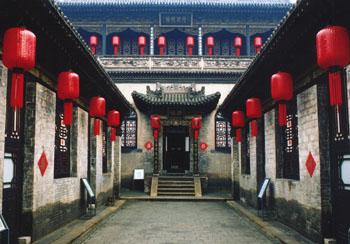 After
breakfast in the hotel we'll make the 6 hour drive to Datong. On
our way to Datong we'll first stop at the Qing Family Compound.
This extensive compound was originally constructed in 1756 by
Qiao Guifa, who made his fortune selling tea and bean curd in
Inner Mongolia. He returned to his hometown in Qi County and
built his dream house, which was then expanded by later
generations of Qiao's. This magnificent complex is laid out in
the shape of the Chinese xi character, meaning "double
happiness." After entering through the main gate, one finds
oneself on a long path leading to the main hall, which is the
family's ancestral hall. This path divides the compound into
southern and northern sections. Both halves have three
courtyards each, and these six courtyards in turn include 20
smaller courtyards, 313 rooms, and a number of gardens spread
out over a two-acre piece of land. The compound impressed
visitors not just for its size but also for the exquisite
craftsmanship displayed in the brick carvings, woodwork, murals,
and inscribed tablets. The wide variety of different roof styles
is particularly interesting to see, and there are over 140
chimneys in the compound, each having its own design. Zhang
Yimou's popular film, Raise the Red Lantern, was filmed here. After
breakfast in the hotel we'll make the 6 hour drive to Datong. On
our way to Datong we'll first stop at the Qing Family Compound.
This extensive compound was originally constructed in 1756 by
Qiao Guifa, who made his fortune selling tea and bean curd in
Inner Mongolia. He returned to his hometown in Qi County and
built his dream house, which was then expanded by later
generations of Qiao's. This magnificent complex is laid out in
the shape of the Chinese xi character, meaning "double
happiness." After entering through the main gate, one finds
oneself on a long path leading to the main hall, which is the
family's ancestral hall. This path divides the compound into
southern and northern sections. Both halves have three
courtyards each, and these six courtyards in turn include 20
smaller courtyards, 313 rooms, and a number of gardens spread
out over a two-acre piece of land. The compound impressed
visitors not just for its size but also for the exquisite
craftsmanship displayed in the brick carvings, woodwork, murals,
and inscribed tablets. The wide variety of different roof styles
is particularly interesting to see, and there are over 140
chimneys in the compound, each having its own design. Zhang
Yimou's popular film, Raise the Red Lantern, was filmed here.
After lunch we will drive 3.5 hours to
visit the famed Hanging Monastery. Perched precariously halfway
up a cliff some 50 meters above a river, the Hanging Monastery
is one of the most remarkable sights in China. Consisting of a
complex of 40 rooms linked together by mid-air corridors and
walkways, this remarkable monastery appears to be glued to the
side of a sheer precipice. Known as "Xuankong Si" in
Chinese--"Temple Suspended in the Void"--this architectural
wonder was built in 490 and has been hanging here for 1400
years. It has been renovated a number of times, most recently in
1900, and much of the current structure dates from the Ming and
Qing Dynasties.
For the evening you will be staying at the
Datong Garden Hotel. Situated in the central downtown area of
Datong, it features a convenient location-adjoining to shopping
malls and only a five-minute drive to such cultural relics and
historical sites as the Drum Tower, Shanhua Temple and the Nine
Dragon Wall.
Day
3: Datong- Yungang Grottoes - Huayan Buddhist Temple-Nine Dragon
Screen (B, L)
Following breakfast we will go to the
signature attraction of Datong, the Yungang Grottoes. They are
excellent examples of rock-cut architecture and one of the three
most famous ancient sculptural sites of China. The others are
Longmen and Mogao.
The site is located about 16 km south-west
of the city, in the valley of the Shi Li River at the base of
the Wuzhou Shan Mountains. The grottoes were mainly constructed
in the period between 460-525 AD during the Northern Wei
Dynasty. They are an outstanding example of the Chinese stone
carvings from the 5th and 6th centuries. All together the site
is composed of 252 grottoes with more than 51,000 Buddha statues
and statuettes. In 2001, the Yungang Grottoes were made a UNESCO
World Heritage Site, the Yungang Grottoes is considered by
UNESCO a "masterpiece of early Chinese Buddhist cave art...
[and] ...represent the successful fusion of Buddhist religious
symbolic art from south and central Asia with Chinese cultural
traditions, starting in the 5th century CE under Imperial
auspices."
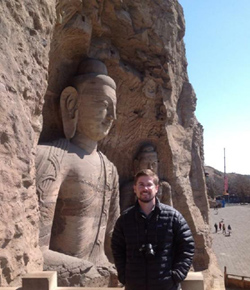 The work on this first period of carving
lasted until the year 465 AD, and the caves are now known as
caves 16*20. Beginning around the year 471 AD, in a second
construction phase that lasted until 494 AD, the twin caves 5/6,
7/8, and 9/10 as well as the caves 11, 12, and probably 13 were
constructed under the supervision and support of the imperial
court. The imperial patronage ended 494 AD with the move of the
Wei court to the new capital of Luoyang. All other caves emerged
under private patronage in a third construction period, lasting
until 525, when the construction came to a final halt due to
uprisings in the area. The work on this first period of carving
lasted until the year 465 AD, and the caves are now known as
caves 16*20. Beginning around the year 471 AD, in a second
construction phase that lasted until 494 AD, the twin caves 5/6,
7/8, and 9/10 as well as the caves 11, 12, and probably 13 were
constructed under the supervision and support of the imperial
court. The imperial patronage ended 494 AD with the move of the
Wei court to the new capital of Luoyang. All other caves emerged
under private patronage in a third construction period, lasting
until 525, when the construction came to a final halt due to
uprisings in the area.
Since the end of the works, the sandstone
of the grottoes is exposed to heavy weathering. The ensuing
centuries therefore ssaw several attempts to preserve the caves
and to repair sustained damage. During the Liao Dynasty the
caves saw some renewing of statues and the buildup of the "10
temples of Yungang" from 1049 to 1060 that were meant to protect
the main caves. However, they were destroyed again just some 60
years later in a fire. 1621, during the early Qing Dynasty,
brought the construction of the wooden buildings that still can
be seen in front of the caves 5 and 6. Since the 1950s, cracks
in the sandstone have been sealed by grouting, and there are
efforts to reduce the weathering due to sandstorms by
forestation.
We should have some time to visit the old
quarter of the city ,Huayan Buddhist Temple and the Nine Dragon
Screen, a 600-year-old screen made of glazed tiles and depicting
nine dragons. This is the oldest glazed screen in China. In
front of the screen is a long, narrow pool of clear water. When
reflected in the pool when there is a light breeze, the dragons
really to appear to be dancing and cavorting.
For the night you will again stay at the
Datong Hotel.
Day
4: Datong-Beijing (via plane) (B)
We will drive you to Datong airport, and
from there you will take flight# CA1120 (09:20/10:25) back to
Beijing, thus ending your tour with us.
|
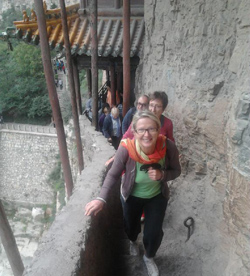
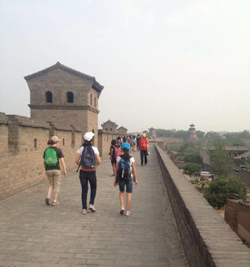

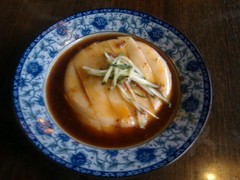
|

